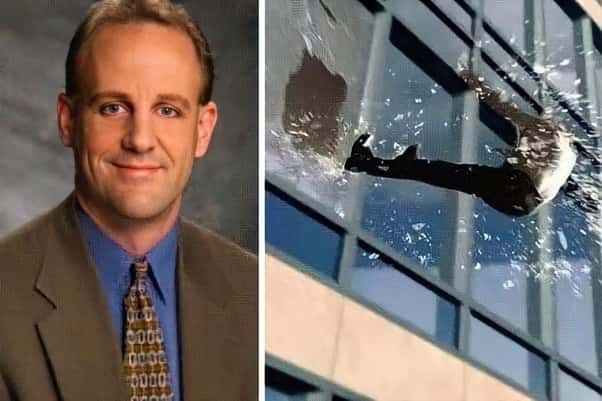Garry Hoy window death: Tragic Death of Lawyer Who Fell from Skyscraper While Proving Window Was Unbreakable

In a shocking and tragic incident, a lawyer lost his life after falling from the 24th floor of a skyscraper while attempting to prove that the building’s windows were unbreakable.
Garry Hoy, a 38-year-old lawyer and engineer, was known for his passion for building safety and modern construction techniques. However, his enthusiasm ultimately led to a fatal accident that left his colleagues and the legal community in disbelief.
Who Was Garry Hoy?
Garry Hoy was a respected lawyer at Holden Day Wilson, a prominent law firm in Toronto, Canada. Before becoming a lawyer, Hoy had earned a degree in engineering, which fueled his interest in building safety and compliance. He was particularly fascinated by the strength and durability of modern building materials, including the windows of skyscrapers. His dual expertise in law and engineering made him a unique and highly valued professional in his field.
The Fatal Demonstration
On July 9, 1993, Hoy’s firm hosted a welcome party for new summer interns in their conference room on the 24th floor of the Toronto-Dominion Centre, one of the city’s tallest skyscrapers. The room offered stunning views of the city, and Hoy had often used the opportunity to showcase the strength of the building’s windows. He had developed a habit of throwing himself against the glass to demonstrate its unbreakable design, impressing his colleagues with the window’s ability to withstand his weight.
During the party, Hoy decided to perform his now-famous demonstration for the new interns. Confident in the window’s strength, he threw his full weight against the glass. The first attempt went as planned—the window held firm, and Hoy bounced back, unharmed. However, when he repeated the stunt, tragedy struck.
What Went Wrong?
The second time Hoy threw himself against the window, the glass did not break. Instead, the entire pane popped out of its frame, sending Hoy plummeting 24 stories to the ground below. The horrified interns and colleagues watched in shock as the lawyer fell to his death. Despite immediate medical attention, Hoy did not survive the impact.
Structural engineers later explained that while the glass itself was strong enough to withstand Hoy’s weight, the window frame was not designed to handle such force. A structural engineer told the Toronto Star, “I don’t know of any building code in the world that would allow a 160-pound man to run up against a glass window and withstand it.” This critical flaw in the window’s design led to the tragic accident.
The Aftermath
Hoy’s death was classified as “accidental auto-defenestration,” a term used to describe the act of causing oneself to fall out of a window. The incident served as a grim reminder of the importance of adhering to safety standards and the potential dangers of overconfidence in engineering and design.
Despite the tragic outcome, Hoy’s colleagues remembered him as one of the “best and brightest” at the firm. His passion for building safety and his dedication to his work left a lasting impact on those who knew him. Ironically, Hoy’s belief in the strength of the windows was not entirely wrong—the glass itself did not break. It was the failure of the window frame that led to the accident.
The tragic death of Garry Hoy highlights the importance of rigorous safety testing and the need for professionals to exercise caution when demonstrating structural integrity. While modern building materials are designed to be strong and durable, they are not infallible. Engineers and architects must ensure that every component of a structure, from the glass to the frames, meets the highest safety standards.
For the general public, Hoy’s story serves as a cautionary tale about the dangers of taking unnecessary risks, even in seemingly safe environments. It also underscores the importance of respecting safety protocols and understanding the limitations of materials and designs.
Remembering Garry Hoy
Garry Hoy’s untimely death was a loss to the legal and engineering communities. His passion for his work and his commitment to building safety were commendable, but his tragic accident reminds us that even the most knowledgeable professionals can fall victim to unforeseen risks. Hoy’s legacy lives on as a reminder of the importance of balancing innovation with caution and ensuring that safety remains a top priority in all aspects of construction and design.
FAQs About Garry Hoy’s Tragic Accident
1. Who was Garry Hoy?
Garry Hoy was a 38-year-old lawyer and engineer working at Holden Day Wilson, a well-known law firm in Toronto, Canada. He had a background in engineering and specialized in building safety and compliance, which made him particularly interested in the strength and durability of modern construction materials.
2. What happened to Garry Hoy?
On July 9, 1993, Garry Hoy fell to his death from the 24th floor of the Toronto-Dominion Centre. He was demonstrating the strength of the building’s windows by throwing himself against the glass. While the glass did not break, the window frame gave way, causing Hoy to fall to the ground.
3. Why did Garry Hoy throw himself against the window?
Hoy was trying to prove that the windows of the skyscraper were unbreakable. He had done this demonstration multiple times before without incident, and it had become a way for him to showcase the building’s structural integrity. Unfortunately, this time, the window frame failed, leading to the tragic accident.
4. Did the window break when Garry Hoy hit it?
No, the glass itself did not break. The window pane popped out of its frame due to the force of Hoy’s impact, causing him to fall. The failure was in the window frame, not the glass.
5. What is “auto-defenestration”?
Auto-defenestration refers to the act of causing oneself to fall out of a window, either accidentally or intentionally. In Garry Hoy’s case, his death was classified as “accidental auto-defenestration” because he unintentionally caused himself to fall while demonstrating the window’s strength.
6. Was Garry Hoy wrong about the windows being unbreakable?
Not entirely. The glass itself was strong enough to withstand his weight, which proved his point about its durability. However, the window frame was not designed to handle such force, which led to the accident. This highlights the importance of considering all components of a structure, not just individual materials.
7. What lessons can be learned from this incident?
The tragedy underscores the importance of rigorous safety testing and the need to respect the limitations of building materials. It also serves as a reminder that even confident professionals can make mistakes, and overconfidence in safety measures can have devastating consequences.
8. How did Garry Hoy’s colleagues remember him?
Hoy’s colleagues remembered him as one of the “best and brightest” at the firm. He was highly respected for his expertise in both law and engineering, and his passion for building safety left a lasting impression on those who knew him.
9. Are modern skyscraper windows safe?
Yes, modern skyscraper windows are designed to be safe and durable. However, they are not indestructible. Building codes and safety standards ensure that windows can withstand normal conditions, but they are not designed to handle extreme force, such as a person throwing themselves against them.
10. Could this accident have been prevented?
Yes, the accident could have been prevented if Hoy had not attempted to demonstrate the window’s strength in such a risky manner. Additionally, if the window frame had been designed to handle greater force, the tragedy might have been avoided. This incident highlights the need for comprehensive safety measures in building design.
11. What impact did this incident have on building safety standards?
While this specific incident did not lead to immediate changes in building codes, it served as a stark reminder of the importance of ensuring that all components of a building, including windows and frames, meet rigorous safety standards. It also reinforced the need for professionals to avoid taking unnecessary risks when demonstrating safety features.
12. How can we honor Garry Hoy’s legacy?
Garry Hoy’s legacy can be honored by prioritizing safety in construction and engineering, respecting the limitations of building materials, and learning from tragic incidents to prevent future accidents. His passion for building safety serves as an inspiration to professionals in the field.
